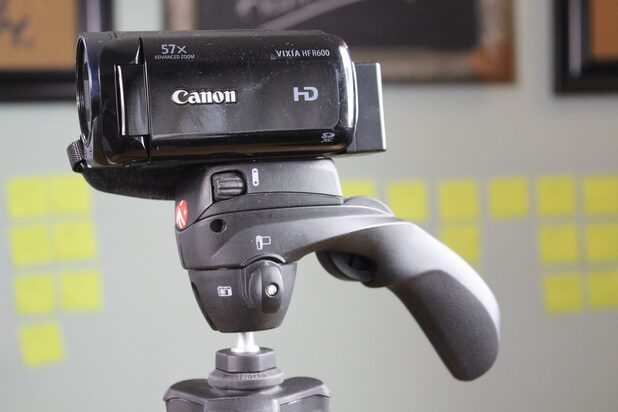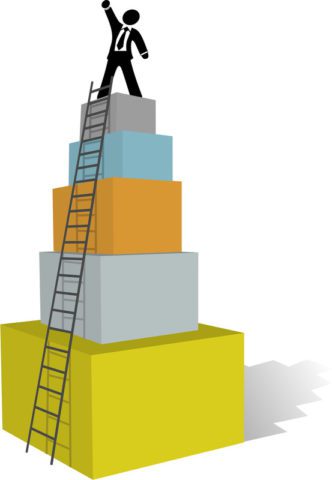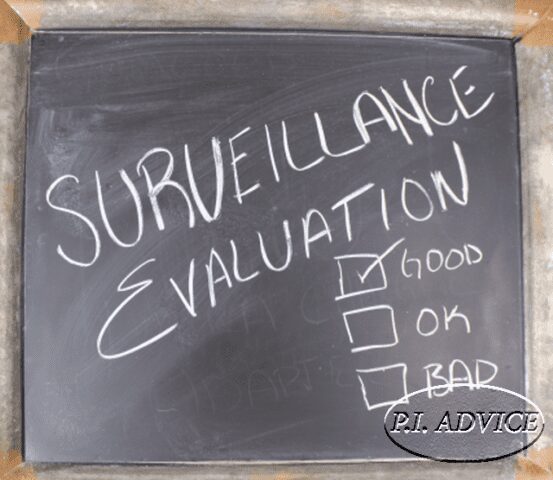Podcast: Play in new window | Download
Anyone in any occupation is evaluated and measured to some degree including the investigation industry. Being evaluated by someone else can be a touchy subject when it comes to this industry. The insurance investigation industry is always evaluating their investigators and rightly so. I have been evaluated since I entered the investigation industry, especially as a surveillance investigator. I am very much aware that there are some surveillance investigators that do some things better than me. Sometimes it’s because I allow them to be better at it (I will explain that later) and sometimes they just do it better.
The investigators that just do something better than I do are the ones I try to learn from. And if there is anything a surveillance investigator should take from being evaluated, it is determining what they can do better.
The push back on what a good video percentage was for a private investigator came as a bit of a surprise. Some didn’t think it was a fair form of measurement, while some explained that there are circumstances that prevent investigators from getting video that is beyond their control. And maybe there were a few investigators that just were not very good at surveillance who didn’t like a video percentage being evaluated. There was no concern that wasn’t shared about video percentages that I hadn’t heard or considered before.
Not to belabor the topic, but a surveillance video percentage can be a big selling point to potential customers. Wouldn’t you as a customer like to hear something like, “ The investigator we are assigning this surveillance to obtains video of the subject on 70 percent of the time”. It sure beats hearing that someone only gets video 40 percent of the time.
To move on from that point briefly (as I will briefly revisit it in a moment), as a company considers how well an investigator performs in the field during a surveillance there are many things to be considered that are not measured or are difficult to measure. It is up to investigator’s supervisor or manager to remember the intangibles when evaluating a surveillance investigator’s performance over a long period of time, like a year.
Contents
- 1 Measuring and Evaluating a Successful Surveillance Investigator
- 2 Video Percentages for Surveillance Investigators
- 3 Preliminary Investigations Conducted by Surveillance Investigator
- 4 Locating an Individual
- 5 Pretext Information Obtained by an Investigator
- 6 Being Billable
- 7 Amount of Video Obtained by a Surveillance Investigator
- 8 Steady Video- Good Video Quality
- 9 Getting Burned by a Subject (Subject Knows They Are Being Followed)
- 10 Losing a Subject While Following Them on a Surveillance
- 11 Quality of a Surveillance Report
- 12 Product Turnaround Time
- 13 Additional Added Budget Time
- 14 Availability of a Surveillance Investigator
- 15 Conclusion on Surveillance Investigator Evaluating
Measuring and Evaluating a Successful Surveillance Investigator

Video Percentages for Surveillance Investigators
As previously stated the video percentage for the amount of time the investigator documents a subject they are assigned to conduct surveillance on is important. The percentage should be averaged over a year’s time. In short, if you are at 65% or above, you are doing very well. I talked about this in a more detailed fashion in the article that discusses what a good video percentage is for a surveillance investigator.
Some the intangibles that I believe should be considered are interchangeable in the sense that they sometimes work together in creating a successful surveillance investigation.
Preliminary Investigations Conducted by Surveillance Investigator
Every surveillance investigation should begin with a preliminary investigation. This is an instrumental part of the foundation for a surveillance. A preliminary investigation helps an investigator to learn more about the subject in relation to the following:
- Finding Known Associates
Through a preliminary investigation, you can find out who a subject hangs out with, who their spouse is, how many children they have, or even finding out more information through the location of known associates. Finding people known to be associated to someone can be overwhelming useful and sometimes not helpful at all. Using known associate information can sometimes help connect the dots to other types of information.
- Confirming the Provided Address is Correct
- Locating Registered Vehicles
- Finding Different Addresses Associated to the Subject
- Locating and Confirming Phone Numbers
- Learning about Legal Problems Through Court Records Searches
- Finding Photos of the subject
An investigator should not be solely relying on information provided by a client. In many cases, the information can be old, outdated or simply not correct at all.
I had one surveillance where a client provided the wrong picture of the subject I was to follow. If it wasn’t for my preliminary investigation I would have never determined who the subject was as quickly as I did.
Locating an Individual
Locating an individual is one of those intangibles that isn’t tracked very often by investigation companies, but it very important to a surveillance having any chance of success. Good investigators can use pretext skills(discussed next) along with preliminary investigation efforts to help in determining where a subject is living or any information in determining where a subject might be. It takes many different skills, many of which are discussed in this article to find people.
Pretext Information Obtained by an Investigator
Pretexting is another one of those intangibles that is never tracked and measured but it can be the critical difference in locating an individual especially one that is trying not to be found.
A phone pretext to a subject might bring about the true address a subject is living at or where they can be found. A pretext to a neighbor may reveal new information where a subject may have moved to.
Pretexting might reveal the types of vehicles someone drives or where they work. Pretexting can be a game changer during an investigation if done correctly and legally.
I personally only use pretexting as a last resort. I conduct better surveillance assignments the less I insert myself into the life of the subject I am conducting surveillance on.
Being Billable
Being billable to a company (or your own company) is critical to the financial success of a company.
A surveillance investigator that consistently bills out 8 hours or more a day is very valuable to an investigation company. There is a lot of things that go into being billable which I will touch on in another article.
Basically, if a surveillance assignment is given to conduct 3 days of surveillance (24 hours) and the surveillance investigator can complete the assignment is 3 days or sooner (billing 8 hours a day or more) the investigator will have completed the assignment on schedule or ahead of schedule. This makes the investigator available for more assignments which in turn makes more money for the investigator and the company.
On the flip side, if it takes 6 or more days to complete a 24-hour budget, the investigator is providing less value to the company. Taking longer to bill out an assignment could be associated to getting burned, losing a subject while following them, or by the subject just not being home.
Now, of course, it is not the investigator’s fault of the subject is not home and it is not the investigator’s fault if the client has some crazy instructions regarding the time spent on a surveillance. Not every assignment is has a subject that isn’t home and crazy expectations from the client. So because not every assignment has circumstances out of an investigator’s control, an investigator’s billable time should be tracked.
Amount of Video Obtained by a Surveillance Investigator
If you have listened to my podcasts I am sure I have discussed the good old days when I use to compete against other employees in in the company for bragging rights. Sometimes it was the monthly video percentage, sometimes it was how much spy cam footage I could get in a day, sometimes it was how much video I could get in a day.
Getting as much video as you can during a surveillance without compromising the investigation allows for the client to have as much information to work with as possible when making a decision.
Securing as much video as possible also helps to ensure you aren’t missing that critical moment needed by the client. For insurance investigations, it might be the claimant doing something that breaks their restrictions. For infidelity investigations, it might be the subject holding hands with someone or kissing someone. If you turned off your camera unnecessarily you might miss that moment. If you didn’t put yourself in a good position to obtain that video you might miss that critical moment.
No one should be turning off their camera because a claimant in an insurance investigation isn’t doing anything or is doing something that doesn’t seem exciting. That is a big no-no because those are the times that something significant might happen and you will miss it because you were selectively videotaping.
And from a client perspective, imagine they have one investigation company that never gets more the 5 to 10 minutes of video on each surveillance and they compare it to a company that averages 20 to 40 minutes of subject’s activity on each file. Which company would you start to favor over time?
So consider this subtopic more about making the most of your opportunities and not about the files where a subject never comes out of their home.
This I believe this is something that should be tracked regarding a investigators performance.

Steady Video- Good Video Quality
This has been measured by companies I have worked for in the past. The video was scored based on the steadiness of the camera and the quality of video (Clear, focused, no video of the inside of an investigator’s vehicle).
This comes down to pride in providing a quality product. It also comes down to getting clear documentation.
If your video is shaky and someone has a limp, how will someone be able to determine that if someone is limping? If it is shaking how can someone see if the individual is not limping. That is why steady footage can be crucial during as surveillance.
Furthermore, if your video is always out of focus it might be difficult to videotape individuals faces clearly which might be critical when in court.
I still remember years ago when I obtained amazing footage of a claimant and secured hours of footage. I did not use a monopod or a tripod during the surveillance. And one day I had to appear in court for the insurance claim. As we watch the video I obtained during that surveillance in court with the lawyers and judge, I cringed at the amount of camera shake I had. I was embarrassed and couldn’t wait to get to part where it wasn’t shaking. Lucky for me the claim did not involve a limp but if it did, I don’t know how well my video would have stood up in court.
I invested in a monopod and tripod after that. Trust me when I say my video quality increased significantly.
Having steady, clear video is important and should be monitored.
Getting Burned by a Subject (Subject Knows They Are Being Followed)
Conducting a surveillance while being unnoticed is just as important as many other things during a surveillance. This also figures into being billable which was discussed earlier in this article. And because gettering burned does related to billable time, a number of times you are burned should be tracked.
If you get burnt during a surveillance, surveillance efforts are either discontinued permanently or put on hold for an extended period of time.
Getting burned also lowers the chances of the surveillance assignment being reassigned for more time.
Keeping track of the number of times you are burned during a surveillance may help you determine if something you are doing needs to be changed or tweaked to have less of a chance of the person you are following finding out that you are following them.
Having fewer burns is better for the investigator and the company.
Losing a Subject While Following Them on a Surveillance
Though I am not the biggest believer in this being tracked, it should be. And yes I know, there are so many different things that can impact how an investigator follows someone on the road. I know this and agree with you completely.
But there are things an investigator can do to minimize mistakes that can create situations where they lose people more often than they should. An investigator can only control the things they do during a surveillance.
This is one of those things that I kind of let people be better than me at. I drive safe when conducting surveillance and if I am following a person that doesn’t drive safe or too fast, I do what I can, as safely as I can to stay with the person. Being safe can cause me to lose people that are driving unreasonably. There are investigators that will run red lights, speed and be unsafe. Those are the investigators that I let be better than me because I am not willing to be a liability to others.
Losing people makes it harder to get video and makes it difficult to be billable. That is why tracking lost claimants (that end a surveillance day early) should be tracked.
Quality of a Surveillance Report
I was taught early on in my career that a report must provide enough detail that the client only needs to read the report to understand what took place during a surveillance.
This means an investigator needs to be detailed and thorough when writing a report. Describing the things that need to be described, explaining movements of a claimant for insurance-related surveillances, and providing addresses for locations visited by you or the subject. These are just a few of the elements in a good surveillance report.
Spelling errors and incomplete sentences can be a distraction in the product and can show a lack of quality and professionalism if errors are frequently noticed on a report.
If you work for a company and there is someone proofreading your reports, you can imagine that your errors will create more work for them. This will slow down the turnaround time for the product which is next on the things to discuss.
The quality of a surveillance report should be tracked.
Product Turnaround Time
Product turnaround time begins when the assignment is given to either you as a business owner or the company you work for. This too must be tracked for efficiency. Of course, there will be things out of your control but we only need to focus on the things as investigators that we can control.
So going back to some of the things previously discussed we want to be billable, not get burned and not lose people during a surveillance.
As employees we want to have our final report completed by the last day of the surveillance or by the following day. All video should be sent to the company you work for by the follow day of the last day of surveillance.
If all goes well and everything by the investigation employee is sent into the company in a timely manner, the company can take the time to proofread reports and to ensure all report times match the video obtained.
As business owners we should have everything ready to send to the client no later than 2 days after the last day of surveillance.
Any client is looking to get their product sooner than later. This is something insurance companies consider when hiring investigation companies to work on their behalf. If the turn around time for an assignment is consistently slow they will consider another company to do the work for them.
So avoid any delays in getting the final product to the company your work for or to the client directly.
Additional Added Budget Time
Nothing makes an investigation business happier than when they get more work from a client. Additional budgeted time for a surveillance assignment is a great way to earn more money per file assigned. Many times this metric is tracked to show how well an investigator is doing on their files or because it relates to conversations an investigator has with a client which in turn prompts a client to ask for more surveillance time
Investigators who are able to provide additional suggestions to a client in regards to finding video opportunities to document a subject may transfer in more budget time on that specific individual or assignment.
While this doesn’t relate necessarily to how well an investigator does during a surveillance, it might relate to how this investigator is able to communicate with clients which translates to client trust.
Availability of a Surveillance Investigator
This is an intangible that isn’t likely tracked (at least not on paper).
If you are a full-time investigator with an investigation company you are likely already working more than you would like. Sometimes investigation companies need an investigator to work on a holiday or on an investigator’s day off. An investigator that is willing to do this for a company is an asset and makes them more valuable to a company.
If you are an employee, you can be sure that managers who assign surveillance assignments love an investigator that is always willing to be available for any assignment.

Conclusion on Surveillance Investigator Evaluating
There are some things that are easy to measure and there are some things that aren’t so easy to measure. Companies definitely want a well-rounded investigator that is capable of performing on an above average level in all aspects discussed in this article whether measured or not. Sometimes it is the owner or manager of a company that can see the small things that can sometimes go unaccounted for. If a manager or owner can see those things, then they know what they really have in that investigator (good or bad). Being good in these different things will help you get a private investigator job with a company doing surveillance as well.
I am interested in your thoughts on this and whether you would add anything to this list. Be sure to share your thoughts in the comments.
Andrew
Recent Posts
Hawaii is probably one of the most interesting states to work as a private investigator if you are not used to the culture or a native of the state. And if you are not a local, that is something...
How to become a private investigator in Georgia

